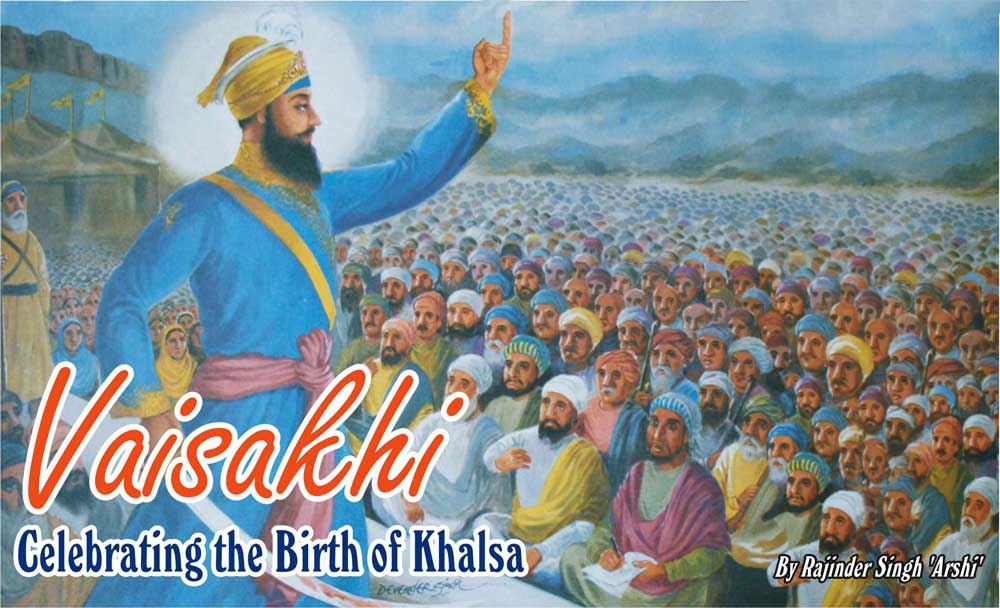
Introduction
The most important dates on a Sikh’s calendar (when most Sikhs set every thing aside and embrace the memory their Gurus) are:
Birth of Guru Gobind Singh (Parkash Utsav Dasveh Patshah)
This Gurpurb is to commemorate the birth of Guru Gobind Singh (the Tenth Nanak).
Holla Mohalla
This is an annual festival (a tradition started by Guru Gobind Singh when thousands of Sikhs flock to Anandpur Sahib and is spectacle of various disciplines of martial arts, horse riding and displays of military exercises. In addition Kirtan Darbars are organised to cater for the spiritual diet which is the lifeline of practicing Sikhs).
Vaisakhi
In Punjab, an agrarian state, the month of April springs into harvesting activities, the fragrance of crops and the joyous activities in villages are a sight to see. A good harvest brings with it an environment of great excitement and celebration.
For Sikhs this month heralds a new dawn, the Birth of Khalsa. In 1999 Guru Gobind Singh chose Anandpur Sahib on this popular day and season among Punjabis to establish the Order of Khalsa, an Order of saint/soldiers to fight oppression and injustice.
Martyrdom of Guru Arjan Dev
This day is commemorated to recognise the supreme sacrifice made by the Fifth Nanak. On the instructions of the mogul emperor, he was tortured to death, undergoing hot sand and water baths. He was made to sit on a hot plate in the hottest month of the year. The Guru happily endured these tortures as the Will of the Lord.
Pehla Prakash Sri Guru Granth Sahib
The day that the Guru Gobind Singh, ordained the Adi Granth to be the next and the Final Guru of the Sikhs. This ended the human lineage of Gurus and the Adi Granth became the respected and revered ‘Holy Guru Granth Sahib’. Guru Gobind Singh proclaimed that the authority of the Sikh Gurus shall in future vest in Guru Granth Sahib, which should be given the same respect, loyalty and authority accorded to Guru Nanak and his nine successors.
Guru Nanak Parkash Utsav
This Gurpurb commemorates the day Guru Nanak was born in Nanakana Sahib (now situated in Pakistan). Large scale congregations are seen in Gurdwaras, worldwide, celebrating the day with great devotion and fervour.
Martyrdom of Guru Tegh Bahadur
The Ninth Nanak, Guru Tegh Bahadur on this day took up Aurangzeb’s challenge. The emperor’s most cherished dream was to convert the whole of India to Islam. On the request of Kashmiri Pandits Guru ji accepted the challenge of Aurangzeb and pledged that all Indians would accede to the emperor’s wishes if he could persuade Guru Ji to adopt Islam. Despite many tortures, Guru Tegh Bahadur remained steadfast in his resolve and in the end gave his head for safeguarding others’ right to practice their faith. He was beheaded in Chandni Chowk, Delhi in November 1765. For this extreme sacrifice Guru Tegh Bahadur is known as ‘Hind di Chadar (the shield of India).
Other Events
Although the above are the more common dates highlighted on a Sikh’s Calendar, it does not mean the other events (such as the battle of Chamkaur Sahib, martyrdom of the Sahibzade Fateh Singh and Jujhar Singh) are of lesser importance. In fact these events are the most narrated discourses by kathawachaks and dhadhi jathas. Those whose hearts and soul are dedicated to Sikhi observe every significant date religiously conscious of the sacrifices made by their Gurus.
Background
The purpose of this article is not to regurgitate the detailed events of the Vaisakhi Day of 30 March 1699, the day the Khalsa was born, but appreciate its significance then and now. Thousands of articles have been written detailing the events of that day and even today Sikhs argue on a number of details while forgetting its objective and long-term purpose.
Guru Gobind Singh, like his predecessors, was a visionary Guru. He from the very beginning aspired to create a man (woman) who would be pure in thought, just in action and divine of soul. His disciples would be men and women of character, pure, emancipated and sovereign. They will not endure injustice or insubordination of any form. He first hinted on the creation of this ideal person (Khalsa) when he learnt that not a single Sikh came forward to claim the body of his father, Guru Tegh Bahadur, when he was mercilessly beheaded in Chandni Chowk, Delhi in November 1765. The Ninth Nanak, along with his most beloved Sikhs, laid down his life for the freedom of people of all faiths to practice their religion without fear or intimidation. It may not be exaggeration to say that Guru Tegh Bahadur Ji’s sacrifice laid the foundation stone of the birth of Khalsa, although the concept was in place as early as Guru Nanak when he proclaimed:
ਜਉ ਤਉ ਪ੍ਰੇਮ ਖੇਲਣ ਕਾ ਚਾਉ ॥ ਸਿਰੁ ਧਰਿ ਤਲੀ ਗਲੀ ਮੇਰੀ ਆਉ ॥ ਇਤੁ ਮਾਰਗਿ ਪੈਰੁ ਧਰੀਜੈ ॥ ਸਿਰੁ ਦੀਜੈ ਕਾਣਿ ਨ ਕੀਜੈ ॥ (SGGS 1412)
jao tao prem khaylan kaa chaao, sir dhar talee galee mayree aao. it maarag paer dhareejai, sir deejai kaan na keejai. || (SGGS 1412)
If you are yearning to play the game of love (devotion), then, come, step onto my street (Guru’s Path) with your head on your palm. You must not waver when you set foot on this journey (i.e. there must be no doubts or regrets when offering your head).
Offering one’s head in this manner means absolute sacrifice, physically, mentally and spiritually.
This concept was first given a practical form when Guru Hargobind (grandfather of the Tenth Master) introduced the qualities of miri (temporal power) piri (spiritual disposition) in the Sikh persona. A Sikh must be a complete person – spiritual in the pursuit of Truth (piri) and steadfast in procuring justice for all (miri). Guru Hargobind began a mission which could not be accomplished in a few years, i.e. character building which in the course of testing times would weather the storms, carrying forward a spirit which the Tenth Master could work upon for transformation to Khalsa. A quite period followed after the departure of Guru Hargobind. Guru Har Rai, the Seventh Nanak concentrated on establishing and developing hospitals and centres of herbal medicine. This period plus the brief period of Guru Har Krishan’s Guruship was a consolidating time for the Sikhs. This, on hindsight, proved to be a lull before the storm.
Guru Tegh Bahadur (the Ninth Master – the youngest son of guru Hargobind) was a soul of deep mystical temperament although he was also well versed in archery, swordsmanship and the martial arts. It was during his tenure as the Sikh Guru that Aurangzeb, the mogul emperor, who had always cherished the conversion of the whole of India into an Islamic state, became so obsessed with the idea that he launched a vigorous programme of converting Kashmiris forcibly to Islam. A distinguished group of Kashmiri Pandits (Brahmins) came to Guru Tegh Bahadur for help. Guru Ji asked them to tell the mogul emperor that they will willingly embrace Islam if he could convince their Guru (Ninth Nanak) to do the same. Guru Ji was arrested on the orders of Aurangzeb along with some of his followers, Bhai sahibs, Diyala, Mati Das and Sati Das. Before departing for his certain martyrdom Guru Ji nominated his son Gobind Rai (later Guru Gobind Singh) to be the Tenth Master.
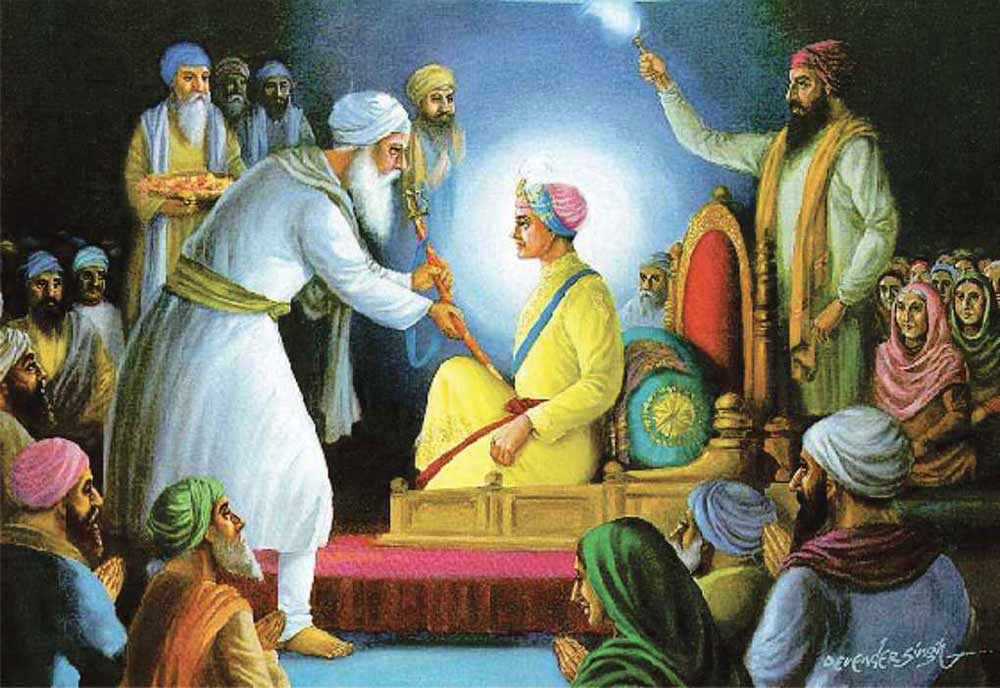
It is a well recorded fact in the annals of Sikh History that despite many tortures, Guru Ji remained steadfast in his resolve and in the end gave his head for safeguarding others’ right to practice their faith. He was beheaded, in public, in Chandni Chowk, Delhi in November 1765. For this extreme sacrifice Guru Tegh Bahadur is known as ‘Hind di Chadar’ (the shield of India). He laid down his life and the life of his beloved Sikhs for the religious freedom of all, not just Sikhs.
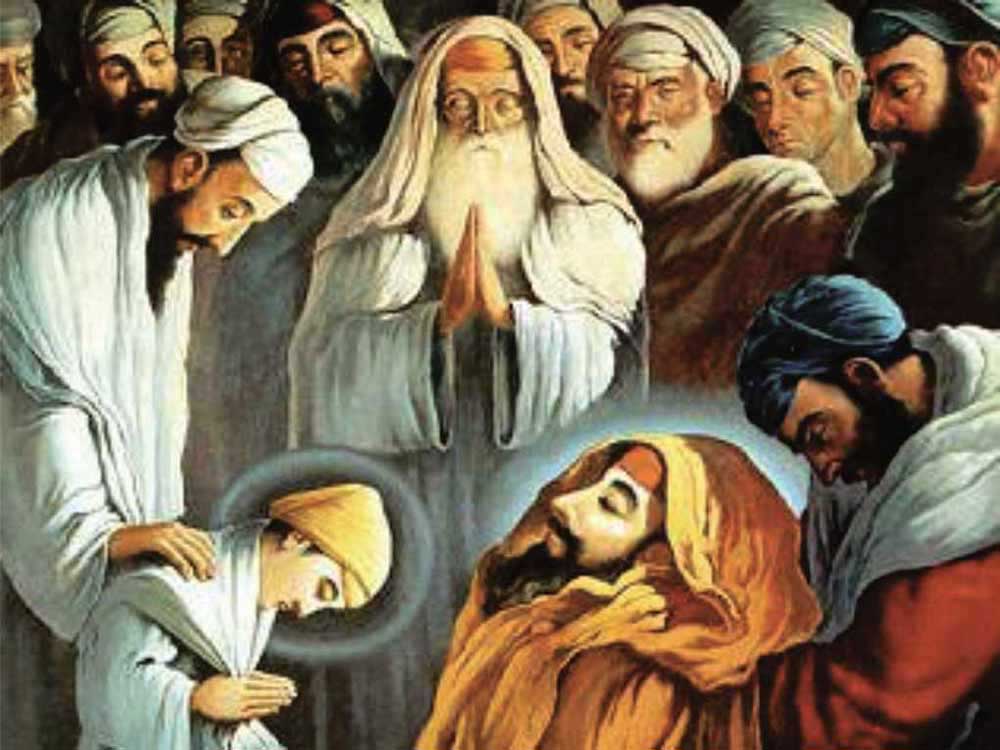
The Seeis (Sacred Head) of Guru Tegh Bahadur
There were many Sikhs in the public, amongst Hindus and Muslims, witnessing the beheading, yet no one had the courage to claim the body of Guru Ji. However, during the dark stormy night Lakhi Shah, a disciple of the Guru Ji, clandestinely, carried his body to his house and set it on fire in order to cremate Guru Ji’s body. The head of Guru Teg Bahadur was collected by another Sikh, Bhai Jaita (later Bhai Jivan Singh) at great risk to his own life.
It is both important and relevant to mention here that while Guru Amar Das had established twenty two manjis (dioceses – the circuit or extent of a bishop’s jurisdiction) in different parts of India, Guru Arjan Dev during his time as Guru had appointed masands (Guru’s envoys). Their job was to spread the message of Sikhi in their areas and also to collect the offerings made by the Sikhs to the Guru Ghar for serving the Sikh cause and welfare. In time, these masands had become very powerful, extremely corrupt and egoistic. The departure of Guru Tegh Bahadur and the masand issue signaled a complete shake up of system. The time had arrived to strengthen the panth by instilling into its followers a spirit which will sustain their spiritual and temporal qualities. The form and character of the new-born Sikh (Khalsa) would be such that he will not seek to make himself inconspicuous like the Sikhs who witnessed Guru Tegh Bahadur’s beheading. The Khalsa would be noticeable in a crowd of thousands. There will be no scope to hide.
There is a general belief that Guru Gobind Singh had resolved to create the Khalsa when Bhai Jaita related the tragic scenes and events of Chandini Chawk. To us mortals this would seem logical. However, Guru Gobind Singh was no ordinary person. When and how he resolved to create Khalsa is best known to Guru Ji.
It was under these circumstances that Guru Gobind Singh rose on this historic day to create the Khalsa. He was looking for special people, within the community, who would take on the challenge and rise above the frailties of the common people; to be strong and fearless; to be prepared to face these challenges without reservation and without resorting to injustice; to be fair and even handed at all times; to be prepared to die for the truth.
Vaisakhi was already a popular event in Punjab, an agrarian state. Towards the end of March the Punjabis spring into harvesting activities and the sweet smell of crops triggers joyous activities. When the harvest is good it further adds to the excitement and colourful celebrations. Sikhs would seize this opportunity to celebrate Vaisakhi as a socio-religious occasion. On the one hand there were melas (fairs) and processions and on the other hand there were Kirtan Diwans and spiritual discourses.
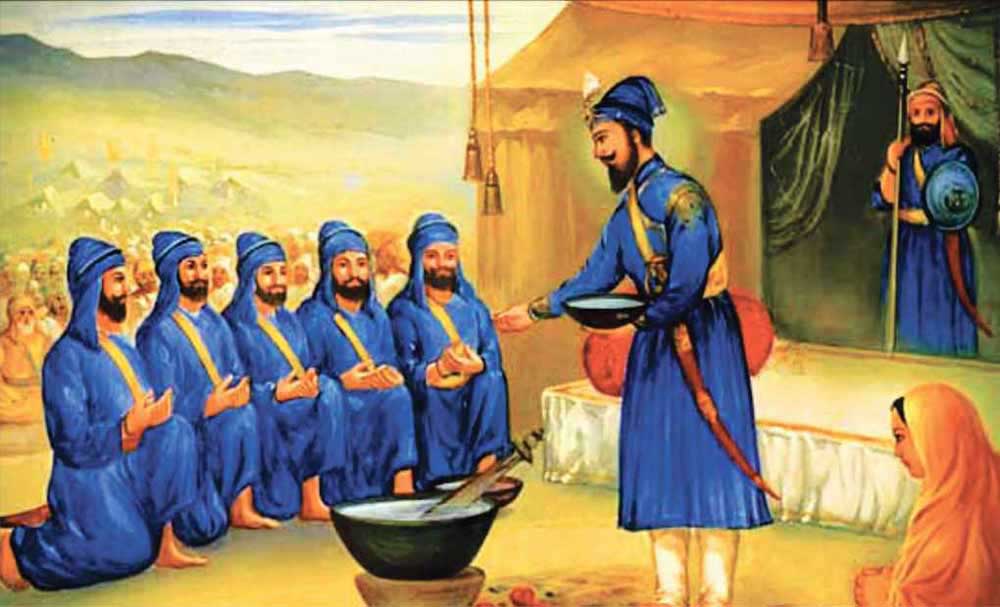
On this particular Vaisakhi Day (1699) Guru Gobind Singh sent out special invitations to all Sikhs to attend the Diwan at Anandpur Sahib. As mentioned earlier, the purpose of this article is not to repeat events which are well covered in books, on the internet and by numerous articles in journals. In brief, Guru Ji put the congregation to test by the sword. He called for one head and amidst the stunned silence Bhai Daya Singh came forward. With a congregation, steadily dwindling in numbers after the first call, he made four further calls and Bhai Dharam Singh, Bhai Mohkam Singh, Bhai Sahib Singh and Bhai Himmat Singh came forward (in that order) to offer their heads. Guru Ji took them to an area cordoned off by a curtain only to return, an hour or so later, dressed in new robes adorned by the five Ks i.e. Kesh (uncut hair), kangga (wooden comb), kirpan (sword – a curved strapped dagger), kashehra (short drawers) and karra (iron/steel bracelet). The transformation was complete; the five Sikhs had ended one life and were reborn as Khalsa on the sharp edge of the sword, but not before tasting nectar from the sweet Amrit prepared by the Guru. The Khalsa was born. The five were named by Guru Ji as Punj Piyare (The Five Beloved). In turn, Guru Ji took the Gift of Nectar (Amrit) from the Five Beloved and in return offered his all; history bears testimony to the price Guru Gobind Singh paid for Amrit. He sacrificed his entire family for the welfare of his Sikhs.
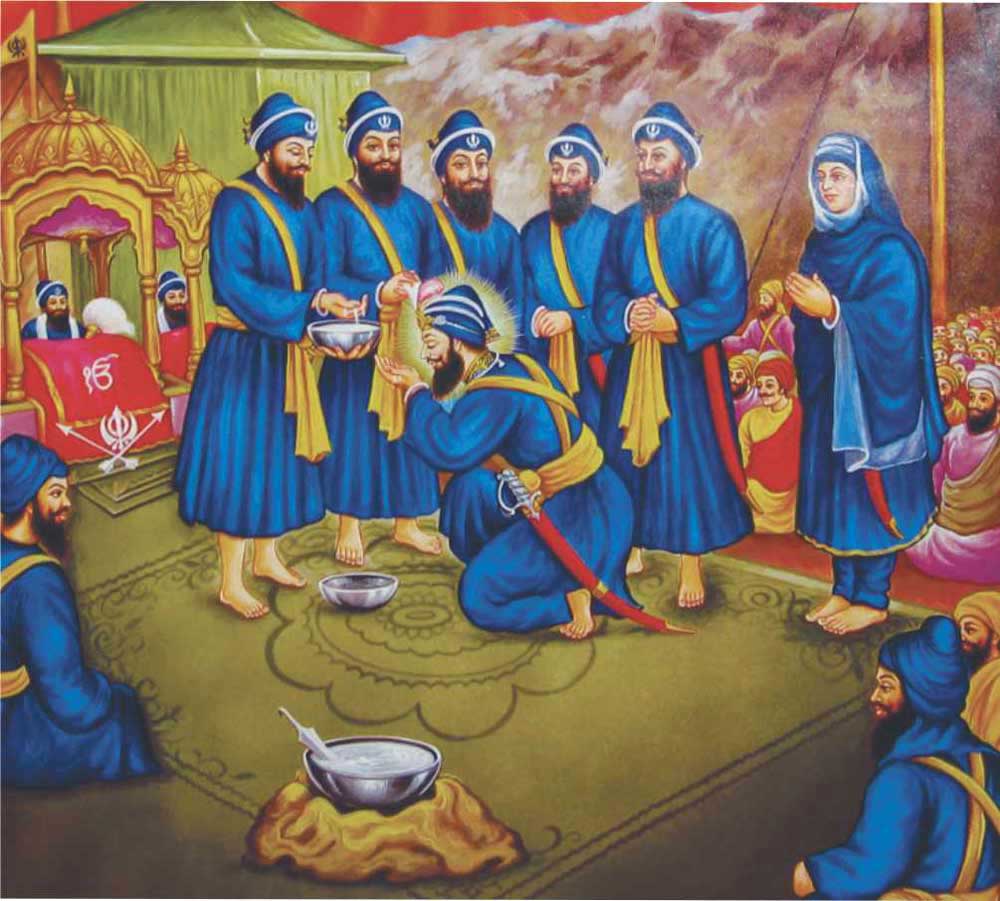
The gift of amrit instilled a new spirit in Sikhs, now distinguished as the Khalsa Order. The discipline which underpinned this identity was rigorous and required absolute dedication to and trust of the Guru. Similarly Guru Ji pledged the same. There was no room for doubting the Guru as now the Guru and disciple were one. Guru Gobind Singh’s famous words epitomise this abiding understanding between the two proclaimed:
ਖ਼ਾਲਸਾ ਮੇਰੋ ਰੂਪ ਹੈ ਖ਼ਾਸ ॥ ਖ਼ਾਲਸੇ ਮਹਿ ਹੌ ਕਰੌ ਨਿਵਾਸ ॥
ਖ਼ਾਲਸਾ ਮੇਰੋ ਮਖ ਹੈ ਅੰਗਾ ॥ ਖ਼ਾਲਸੇ ਕੇ ਹੌਂ ਸਦ ਸਦ ਸੰਗਾ ॥
khalsa maero roop hai khhas. khalsa mehi ho karo nivas.
khalsa maero mukh hai anga. khalsae kae hon sadh sadh sanga.
The Khalsa is my true image and I dwell in the Khalsa.
Khalsa is my principal feature and I am forever with the Khalsa.
The Guru then invited others to take khande di Pahul (amrit) and many thousands came forward. The numbers multiplied with the passage of time. From here on the journey of the Khalsa began and they fought many a battle and proved their mettle by achieving victory against insurmountable odds. After the departure of Guru Gobind Singh, the Khalsa marched on initially under the command of Baba Banda Singh Bahadur culminating in the formation of the Sikh Raj under Shere Punjab Maharaja Ranjit Singh. Such was the potential of Amrit that a nation small in numbers established its supremacy against impossible odds. But gradually Sikhs became lax in discipline and began doubting their Guru. Prosperity amongst the Sikhs led to complacency in attitude. Lack of political maturity and dexterity began to shake the foundations of the Sikh Empire. The division amongst the Sikhs and the treachery within its ranks accounted for the end of the Sikh Raj.
The Demise of The Sikh Raj
Some people believe this came about after the death of Maharaja Ranjit Singh, but seeds of discontent and treachery had been sowed during his life. The Maharaja was a just, fair and a generous ruler. However, he was also a trusting king and occasionally misplaced his trust which some unscrupulous individuals took advantage of. They were successful in creating schisms in the ranks. He had also on occasions strayed from the path of Sikhi, once much to the annoyance of Akali Phoola Singh. He was particularly angered when Maharaja Ranjit Singh married a Muslim woman in Amritsar as per Muslim traditions. Akali Phoola Singh sentenced Maharaja to 50 lashes which the latter accepted. On the request of Akali Phoola Singh, the Panth forgave him for his folly.
The Dogra brothers (Dhian, Gulab and Hira) played a huge part in the demise of the Sikh empire. Their treachery caused the death of many brave and distinguished Sikhs. It was during the reign of Maharaja Ranjit Singh that the Dogras first displayed their evil intents. When General Hari Singh Nalwa was engaged in a battle on the north frontier (Peshawar) he made a call for reinforcements. Dhian Dogra who took the message deliberately failed to inform the Maharaja. General Nalwa despite being tired and unwell led the Sikhs to victory, although losing his life in the process. It is well known that Dhian dogra worked in collusion with the Afghans to bring down the Khalsa Raj and provided them with tactical information to attack Peshawar. At the same time the Dogras ensured that the Sikh army under General Hari Singh Nalwa was starved of all essential aid. They did so by ignoring the General’s messages and keeping Maharaja Ranjit Singh in the dark of the plight of the Sikhs fighting against great odds on the frontier.
Where to Now?
We are currently an extremely divided nation lacking strong leadership and at the mercy of self-serving clergy, babas, Deras and politicians. Every aspect of Sikhism is being challenged by vain individuals ranging from scriptures to the Sikhi Code of conduct. Those who question and stir up unrest in the nation are themselves unaccomplished spiritually and overrate their understanding of Sikh history and scriptures. It is true that in the process some valid points are raised but the manner in which these are done is clumsy and often lacking in ethics.
One thing that vexes the author somewhat is the use of the word ‘orthodox’ when referring to amritdhari Sikhs (Khalsa). They use this term in a derogatory way, hinting that orthodox Sikhs are backward and discriminatory. However, they forget what the term really means. The term ‘orthodox’ is an adjective used to represent someone conforming to the approved form of doctrine, philosophy or ideology. One does not need to qualify the term Khalsa (pure, liberated, sovereign). Every other category should be labeled or qualified in comparison to Khalsa, e.g. sehajdhari (slow developer) Sikh, mona (shaven) Sikh, non-complying Sikh, kachcha (spiritually green) Sikh etc. It is true that some Sikhs who have taken amrit commit acts of apostasy and act in anti-gurmat manner, but that does not mean that Sikhi itself is at fault. We must not follow the erring Sikhs but the Sikh tenets as outlined by the Sikh Gurus and as incorporated in the Guru Granth Sahib.
For sometime, like many others, I entertained the idea that the Sikh diaspora may be able to show the way to the ruling clergy (jathedars et al) in India. But alas, those of us living away from our homeland are becoming just as divided as our brethren back home. The same schisms are becoming apparent in UK, States, Canada etc. A Gurdwara in New York banned amrirdharis from its committee. There are agencies in Canada bent on disrupting Sikh unity. Gurdwaras are being established all the time not so much to accommodate Guru Granth Sahib but more to accommodate ego-centred prabandahks, the self-appointed sants, babas and so called brahmgyanis. However, I must hasten to add that there are a precious few well-meaning ones amongst these, so all may not be lost.
Where will we be in, say, 25 years’ time only time will tell. Will we be in a position to celebrate Vaisakhi in the spirit we have been doing for over 200 years? I pray we do, but again only time will tell.
Author’s notes:
- This is the FIRST DRAFT of the article and there will be many shortcomings. The article will in the near future undergo changes for quality and accuracy.
- For simplicity, throughout this article, I have referred to the masculine gender but, wherever appropriate, this should be read as including the female gender.
- Differences of opinion are inevitable in understanding the Sikh history. It’s the author’s endeavour to quote facts as close to the truth as humanly possible.
Rajinder Singh ‘Arshi’ March 2013
